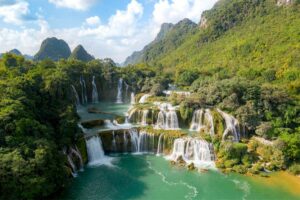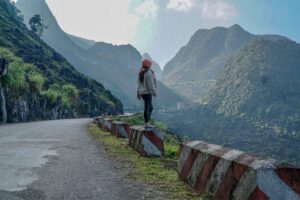Non Nuoc Cao Bang UNESCO Global Geopark, located in the remote northern region of Vietnam, is a remarkable territory recognized for its unique geological heritage, rich biodiversity, and vibrant ethnic cultures. This article will explore the significance of UNESCO Global Geoparks and provide an introduction to Non Nuoc Cao Bang, a geopark that exemplifies the stunning natural beauty and cultural diversity of Vietnam.
What is a UNESCO Global Geopark?
A UNESCO Global Geopark is a unified area with geological heritage of international significance. These geoparks are managed with a holistic concept of protection, education, and sustainable development, aiming to conserve the geological heritage while also supporting the sustainable economic development of the local communities. With over 200 geoparks across nearly 50 countries, these areas are important not only for their scientific value but also for their cultural and natural heritage.
Vietnam’s UNESCO Global Geoparks
Vietnam is home to three UNESCO Global Geoparks, each offering a unique glimpse into the country’s diverse geological and cultural landscapes:
- Dong Van Karst Plateau UNESCO Global Geopark: Located in Ha Giang Province, this geopark is famous for its breathtaking karst landscapes and is a key part of the Ha Giang Loop, a popular motorbike route known for its rugged mountains and deep valleys.
- Dak Nong UNESCO Global Geopark: Situated in the Central Highlands, Dak Nong Geopark is characterized by its volcanic landscapes, including extensive cave systems, waterfalls, and rich biodiversity, making it a fascinating destination for both geologists and nature lovers.
- Non Nuoc Cao Bang UNESCO Global Geopark: The focus of this article, Non Nuoc Cao Bang is a treasure trove of geological wonders, diverse ecosystems, and rich cultural heritage, nestled in the remote mountains of northern Vietnam.
An introduction to Non Nuoc Cao Bang Geopark
Non Nuoc Cao Bang Geopark, recognized by UNESCO in 2018, is a testament to the Earth’s ancient history and the enduring power of nature. Its geological formations, dating back over 500 million years, tell a story of tectonic shifts, volcanic activity, and the relentless forces of erosion. This diverse landscape encompasses towering limestone karsts, subterranean rivers, crystal-clear lakes, and verdant forests, creating a haven for biodiversity and a playground for adventure seekers.
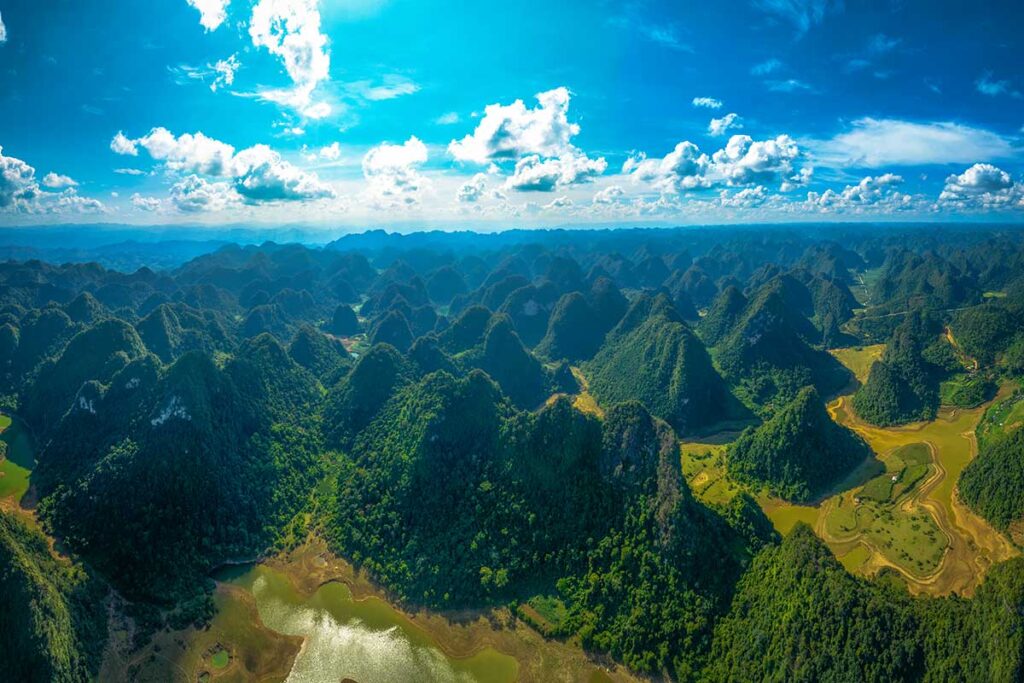
Beyond its geological wonders, Non Nuoc Cao Bang Geopark is also home to a vibrant tapestry of cultures. Nine ethnic minority groups reside within the park’s boundaries, each with its own distinct traditions, customs, and way of life. This cultural richness adds another layer of depth and fascination to the geopark, making it a truly unique destination for exploration and discovery.
Highlights of Non nuoc Cao Bang UNESCO Global Geopark
1. Ethnic Cultures

Non Nuoc Cao Bang Geopark is not just a geological marvel; it’s also a living testament to the vibrant cultures of its nine ethnic minority groups. The Tay, Nung, Mong, Dao, and other communities have inhabited this region for centuries, preserving their unique traditions, customs, and languages. You can experience this cultural richness firsthand by visiting villages, attending traditional festivals, and learning about the local way of life.
2. Ban Gioc Waterfall
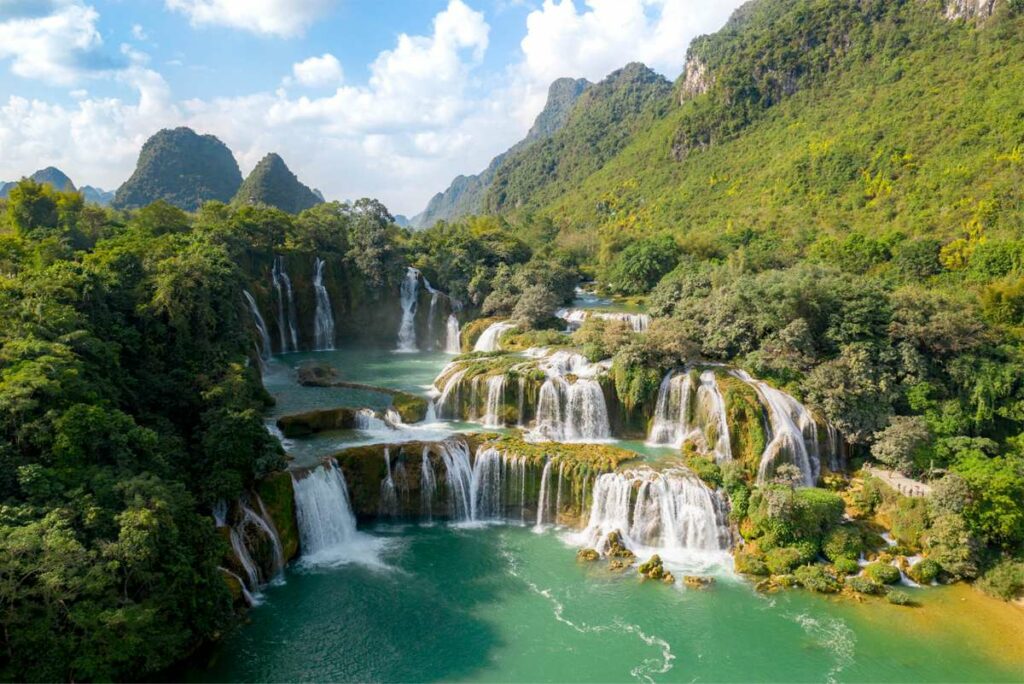
One of the most iconic landmarks in Non Nuoc Cao Bang Geopark is the magnificent Ban Gioc Waterfall, the largest waterfall in Vietnam. This natural wonder, located on the border with China, cascades over multiple tiers, creating a dramatic display of water and mist. The surrounding lush greenery and limestone karsts enhance the waterfall’s beauty, making it a must-visit for any traveler exploring the geopark.
3. Phong Nam Valley
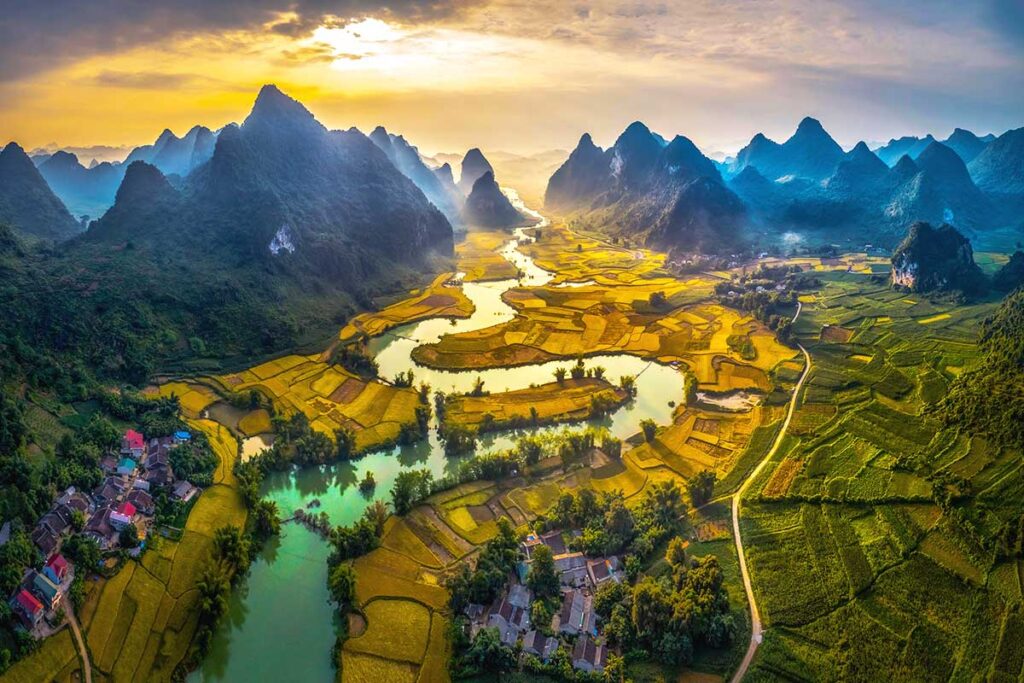
Phong Nam Valley, a hidden gem nestled amidst the limestone mountains, is a picturesque landscape of rice paddies, traditional villages, and meandering rivers. This serene valley offers a glimpse into the authentic rural life of Cao Bang province, where time seems to slow down and nature reigns supreme.
4. Angel Eye Mountain
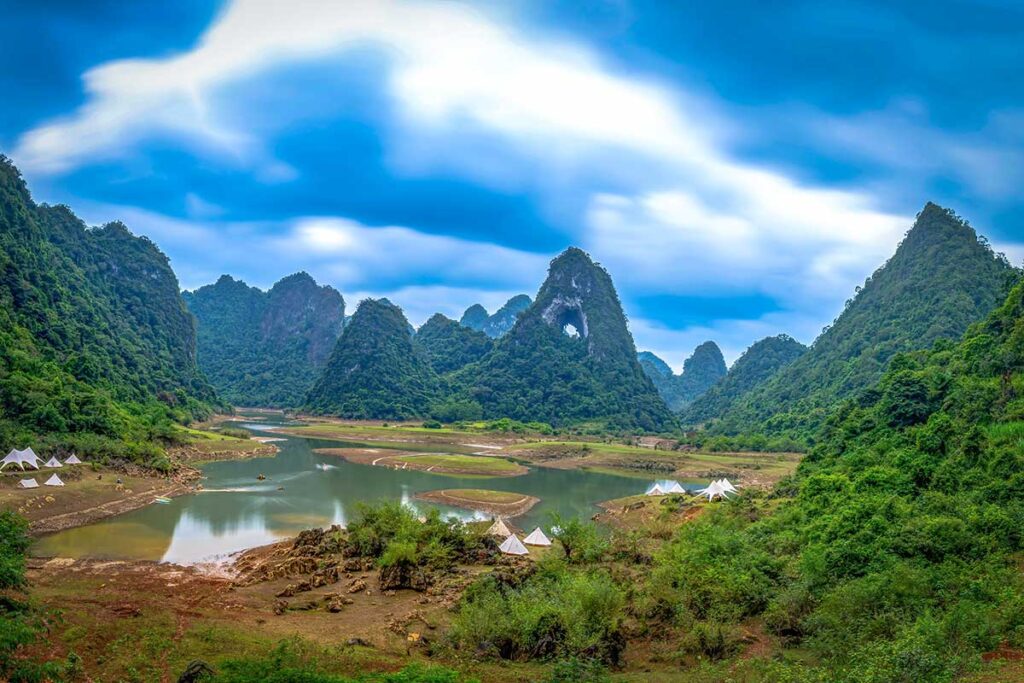
Angel Eye Mountain, also known as Nui Thung Mountain, is a unique geological formation characterized by a massive hole at its peak, resembling an eye gazing down upon the surrounding landscape. The trek to the summit offers breathtaking views of the valley and surrounding karst formations.
5. Thang Hen Lake
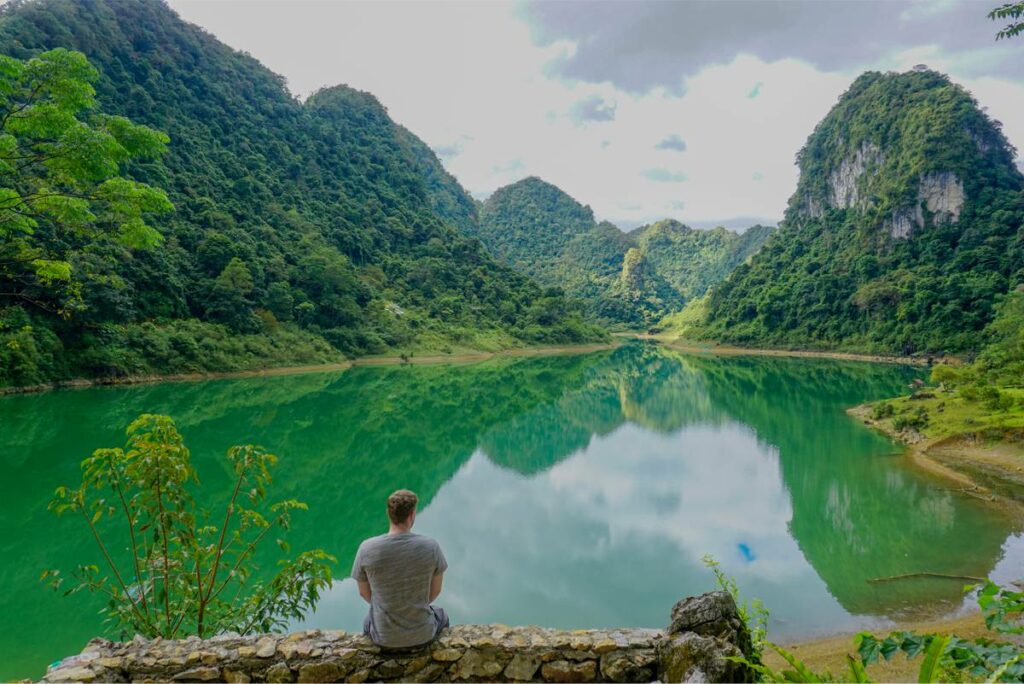
Thang Hen Lake, a cluster of 36 interconnected lakes, is a serene and picturesque destination within Non Nuoc Cao Bang Geopark. Surrounded by lush forests and limestone mountains, the lakes offer opportunities for boating, kayaking, and swimming.
6. Nguom Ngao Cave

Nguom Ngao Cave, also known as Tiger Cave, is a mesmerizing underground world of stalactites, stalagmites, and other geological formations. The cave’s unique beauty and cool temperatures make it a popular attraction for visitors seeking a refreshing escape from the heat.
7. Pac Bo Cave
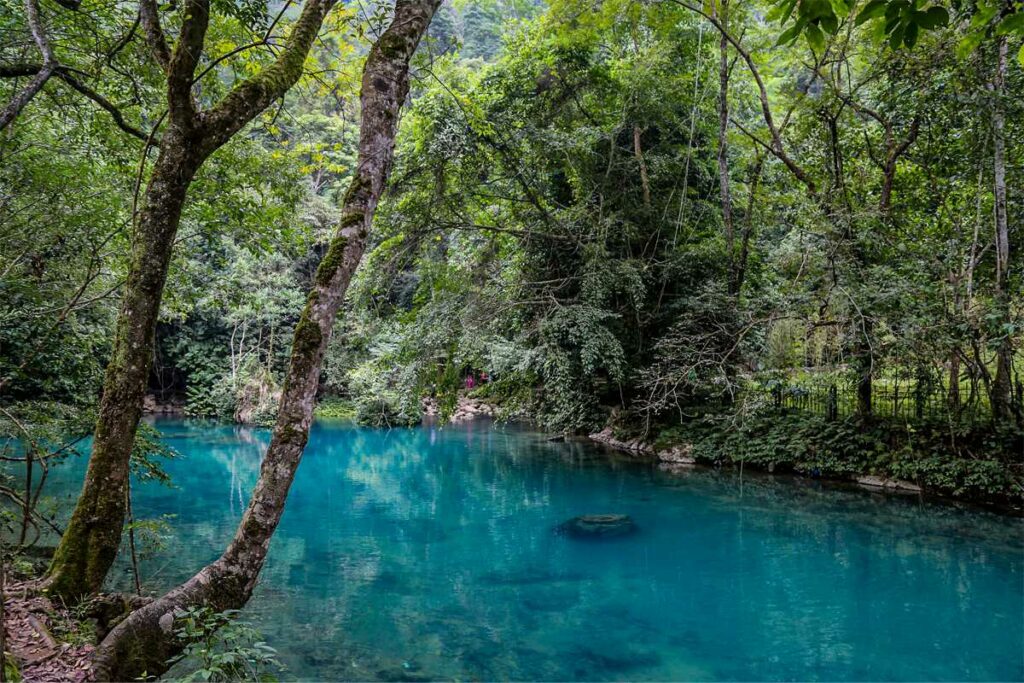
Pac Bo Cave holds historical significance as a revolutionary base for Ho Chi Minh during the struggle for Vietnamese independence. The cave and its surrounding landscapes offer a glimpse into the country’s past and the sacrifices made by those who fought for freedom.
How to explore Non nuoc Geopark
Getting to Cao Bang
Before you can explore the stunning Non Nuoc Cao Bang Geopark, you’ll first need to reach Cao Bang Province. Since Cao Bang is a remote area in northern Vietnam, there are no airports or train stations, so traveling by road is your only option. Here’s how you can get there from Hanoi:
- Sleeper bus: This is a budget-friendly option that allows you to travel overnight and save daylight hours for exploration. However, the comfort level can vary depending on the bus company, and some travelers might find it challenging to sleep on a moving bus. Additionally, there are potential safety concerns associated with overnight bus travel.
- Limousine vans: These offer a more comfortable daytime journey with spacious seats and often include amenities like Wi-Fi and air conditioning. The travel time is similar to sleeper buses, but you’ll be traveling during the day, which might not be ideal if you want to maximize your time in Cao Bang.
- Private car: While the most expensive option, a private car provides the utmost convenience and flexibility. You can travel at your own pace, make stops along the way, and enjoy a comfortable and personalized experience.
Getting around the Geo Park
Due to the remote nature of many attractions within Non Nuoc Cao Bang Geopark, private transportation is the most practical way to explore the region. Here are a few options:
- Drive a motorbike: Renting a motorbike offers the freedom and flexibility to discover the geopark’s hidden corners at your own pace. However, it requires a valid motorbike license, an International Driving Permit (IDP), and some experience navigating mountain roads.
- Motorbike tour with a guide: For a safer and more immersive experience, consider joining a motorbike tour led by a local guide. You’ll ride pillion, enjoying the scenery while your guide navigates and shares insights into the local culture and hidden gems.
- Car with driver: Opt for a car with a driver for a comfortable and convenient journey. This is ideal for those who prefer a more relaxed experience or are traveling with luggage.
At Local Vietnam, we can arrange all your transportation needs in Cao Bang, including transfers from Hanoi, accommodations, and private car or motorbike tours. We can also create a custom itinerary tailored to your interests and preferences, ensuring you experience the best of Non Nuoc Cao Bang Geopark. Check either our Cao Bang tours here or make a custom trip request here.
Best time to visit Non Nuoc Cao Bang Geopark
The best time to visit Non Nuoc Cao Bang Geopark is during the dry season, which typically runs from October to April. During this time, you can expect pleasant weather with clear skies, making it ideal for outdoor activities and enjoying the stunning scenery.
However, each season offers its own unique charm:
- May to September (Rainy Season): While this period experiences more rainfall, the landscapes are lush and vibrant, and Ban Gioc Waterfall is at its most impressive. The rice fields are also a beautiful sight during this time, especially in September and October when they turn golden yellow during harvest season.
- October to December & March to April (Shoulder Seasons): These months offer a good balance of pleasant weather and fewer crowds. The temperatures are mild, and the scenery is still beautiful, making it a great time for trekking and exploring the geopark.
- December to February (Winter): The temperatures can drop significantly, especially at higher altitudes. While the weather is generally dry, it can be foggy and misty, which might obscure some views. However, the winter months offer a unique atmosphere and a chance to experience the geopark’s quieter side.
